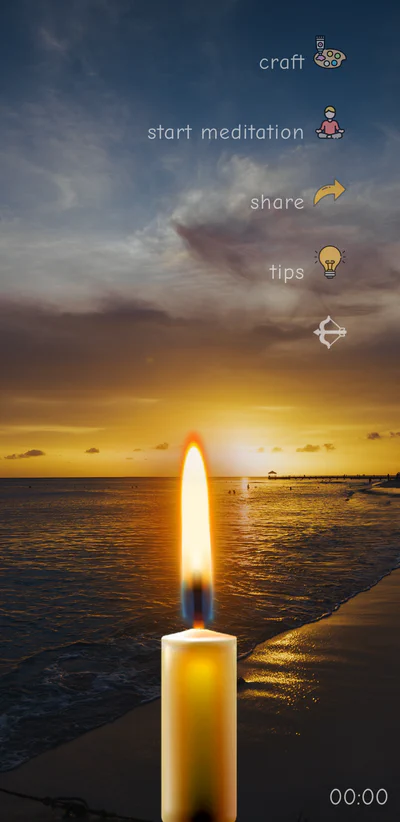Modern-Day Reinterpretations of Tratak
Info
🧠 From ancient caves to clinical labs, Tratak continues to evolve. This article explores how the classic practice of candle gazing is finding new life in modern science, yoga, therapy, and technology.
🔥 Introduction: An Ancient Practice, a Modern Need
Tratak, or candle gazing, has existed for centuries as a tool to cleanse the senses and sharpen inner vision. Today, it’s reemerging—not just in yoga studios but in neuroscience labs, attention rehab clinics, mindfulness apps, and digital detox programs.
In an age of fractured attention spans, eye strain, and cognitive overload, Tratak offers a low-tech, embodied antidote. Its simplicity masks a powerful capacity to harmonize both mental state and visual system.
🧠 Cognitive Science and Visual Neuroscience on Tratak
Newer models of visual attention propose that sustained gazing enhances cortical stability by reducing “neural flicker”—the background activity that distracts cognition. This aligns with the predictive processing model of the brain, where consistent sensory input from the flame minimizes surprise signals, creating internal harmony.
Clinical researchers are also exploring how Tratak can serve as a behavioral anchor in treatments for generalized anxiety disorder (GAD) and cognitive fog in long COVID recovery. When used alongside cognitive restructuring techniques, steady gazing helps patients reconnect with breath, orientation, and bodily awareness.
Some neuro-optometric specialists now recommend Tratak-like routines to rebalance the vestibulo-ocular reflex, especially in post-concussion therapy—showing that ancient techniques are being examined in cutting-edge rehabilitation contexts.
Recent neuroscience research has explored how steady visual fixation affects brainwave states. Studies using EEG suggest that Tratak increases alpha and theta brain activity—associated with relaxed, focused mental states. Learn more about the scientific research on Tratak and brainwaves.
For example:
- A 2021 study in Clinical EEG and Neuroscience showed improved executive attention and working memory in participants performing Tratak for 10 minutes daily.
- Visual tracking studies confirm Tratak enhances ocular stability, leading to better coordination between brain hemispheres.
Flame-gazing also minimizes neural noise, creating ideal conditions for neuroplasticity. Some researchers now consider Tratak a candidate technique for non-pharmaceutical cognitive enhancement.

💻 Digital Detox and Attention Training
Corporate wellness programs increasingly incorporate short Tratak-inspired modules into their employee well-being strategies. Some firms have integrated 7-minute “digital stare resets” into their workday schedules, reporting reduced cognitive fatigue and improved productivity.
Apps like Calm, Headspace, and specialized browser plugins have also started experimenting with focus anchoring tools that mimic Tratak mechanics—minimalist glowing dots or animation loops meant to draw soft, centered gaze during Pomodoro breaks.
We stare at screens longer than ever before. Tratak is gaining popularity as an intentional visual reset—a way to undo the damage of scattered scrolling and device-driven distractions.
Tech wellness brands are adopting Tratak as:
- Focus reset rituals during work sprints
- Mindful gaze routines for eye strain relief
- Pre-sleep wind-downs to lower cognitive agitation
In these settings, Tratak is not seen as spiritual—but as sensory hygiene. Its utility in building oculomotor endurance and soft attention makes it a favorite among digital minimalists and mindfulness coaches.
🧘 Tratak in Modern Yoga Studios and Wellness Programs
Hybrid yoga and tech studios are blending biofeedback devices with Tratak. These setups measure heart rate variability (HRV) or EEG while practitioners gaze into a digital flame, helping them visualize physiological shifts as they deepen their focus.
Some advanced instructors integrate Tratak into sound therapy or color resonance practices, using blue or amber-toned flames to entrain specific brain rhythms or support chakra alignment. These adaptations allow the traditional practice to interface with sensory science, without compromising its essence.
Modern yoga instructors increasingly use Tratak as a tool for:
- Dharana (concentration) training
- Ajna chakra activation
- Anchoring in Yoga Nidra practices
Studios in urban areas run Tratak workshops—typically 5–15 minutes of candle gazing followed by breathwork or journaling. Some integrate it with affirmations, sound bowls, or ambient lighting to create immersive meditative experiences.

For beginners, it becomes a transition practice—bridging physical movement and deeper stillness.
🧪 Clinical and Therapeutic Adaptations
Tratak-inspired methods are entering clinical frameworks as well:
- ADHD focus enhancement trials
- Vision therapy for convergence disorders and digital eye strain
- Complementary practices in CBT and trauma-informed care
In a 2022 pilot study by an Indian neurotherapy institute, Tratak routines were used to lower anxiety and improve auditory memory in students. Occupational therapists have adapted flame-less versions using digital dots or VR fields.
By calming the limbic system and stimulating the retinohypothalamic tract, Tratak appears to regulate emotional reactivity and sleep rhythms. This has attracted interest from psychiatrists, sports psychologists, and even executive coaches.
📱 Rise of Virtual Tratak Apps
Data analytics from popular Tratak apps show high retention for evening use cases—especially when paired with soothing audio backgrounds like ocean waves or wind chimes. Users report subjective improvement in sleep latency and emotional regulation.
Some developers are exploring AI-generated flames that respond subtly to the user’s breath (via microphone) or posture (via webcam), creating an interactive feedback loop that personalizes the meditative state.
Tratak is no longer limited to a candle-lit corner. App developers (like this site’s own project) have built:
- Virtual flames with realistic flicker physics
- Background customization (e.g., forest, temple, minimal)
- Narrated guidance, timers, and mood syncing
- Freestyle and themed sessions (e.g., sleep, focus, clarity)
These tools offer accessibility to users who may not use real candles due to children, pets, or shared spaces. Virtual Tratak provides unique benefits compared to traditional methods. Analytics show users return often to short routines before bed or between work blocks.

This digitization of ritual makes Tratak compatible with modern lifestyles—portable, safe, customizable, yet grounded in tradition.
⚠️ Cautions and Misinterpretations
With popularity comes pitfalls. Misuse of Tratak includes:
- Treating it as a productivity hack without mindfulness
- Performing for too long and causing eye strain
- Reducing it to an aesthetic ritual without inner depth
Experts suggest keeping sessions:
- 5–10 minutes for beginners
- Always accompanied by gentle blinking and breaks
- Guided, if possible, until intuitive understanding develops
As with all meditative techniques, intention matters more than duration.
🌟 Conclusion: Stillness Reimagined
Tratak remains a living tradition—not because it stayed unchanged, but because it adapted. From yogic cleansing to EEG studies, from oil lamps to mobile screens, the practice evolves while the flame remains constant. Explore the historical writings that document this evolution.
In the flicker, we find focus. In the stillness, we return to self.
📚 References
- Sucharit Katyal (2022). Reducing and deducing the structures of consciousness through meditation. Frontiers in Psychology
- Choudhary, M. et al. (2022). Trataka as Ocular Therapy for Digital Eye Strain. Journal of Vision Sciences.
- Deshpande, S. (2023). Meditation and Cognitive Training: A Comparative Study. Clinical EEG & Neuroscience, 54(2).
- Satyananda Saraswati, S. (1981). Asana, Pranayama, Mudra, Bandha. Bihar School of Yoga.
- Singleton, M. (2010). Yoga Body: The Origins of Modern Posture Practice. Oxford University Press.